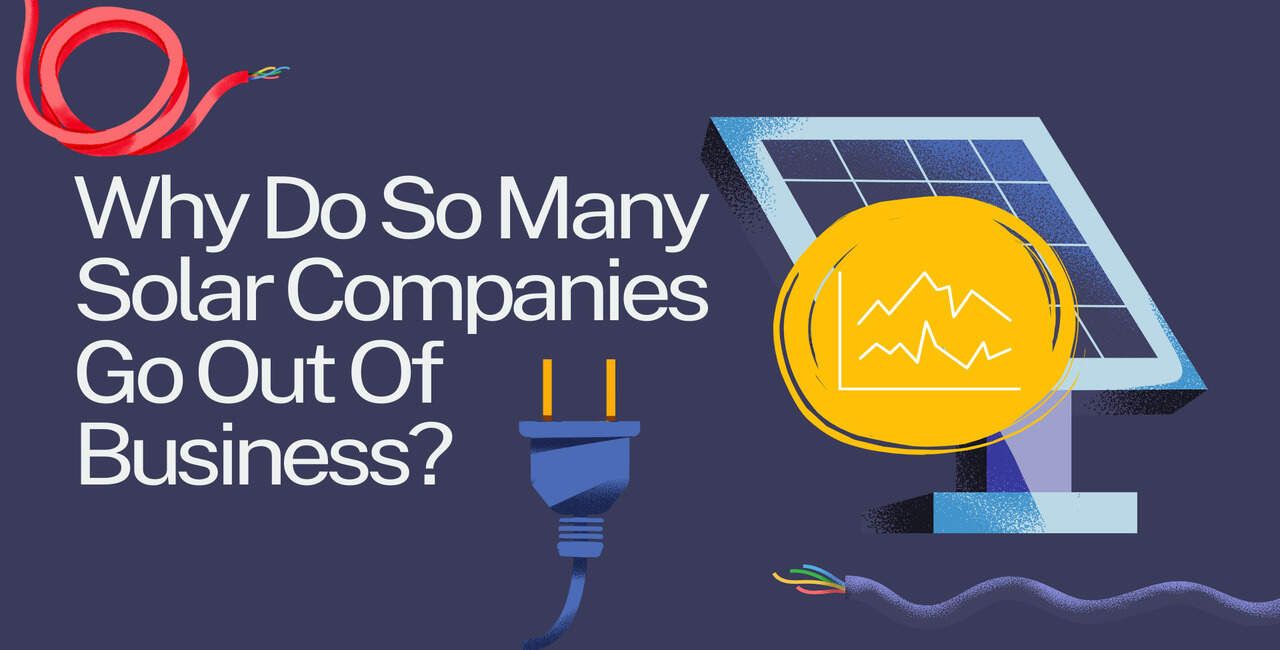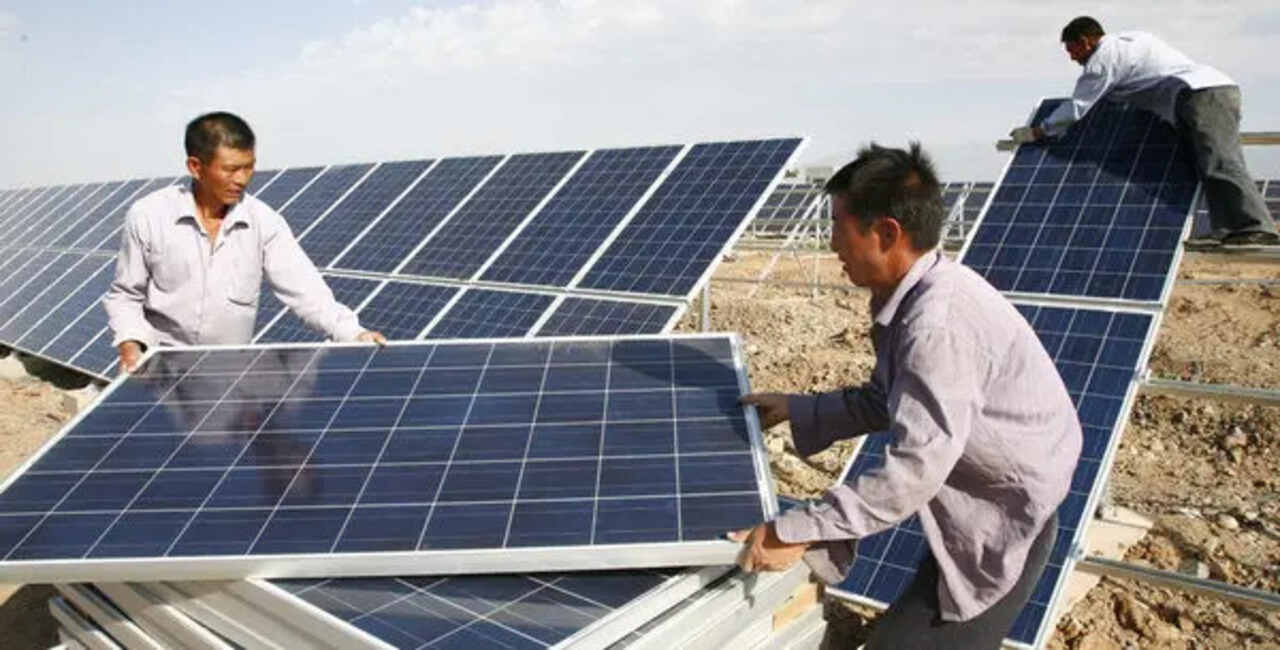Why Do So Many Solar Companies Go Out Of Business?

The global quest for clean and renewable energy sources has spurred the solar industry's impressive expansion in recent years. But in the middle of the exciting developments and growing use of solar technology, an odd pattern has surfaced: a significant proportion of solar enterprises are now confronting the unpleasant reality of going out of business.
This tendency begs the important question, "Why do so many solar companies struggle to sustain their operations and, in some cases, meet an untimely demise, operating in an industry seemingly poised for success?"
Understanding the larger forces at work in the renewable energy sector and, eventually, building a more robust and sustainable future for the solar business, requires unraveling the intricacies behind the difficulties experienced by solar companies.
We explore the many aspects that make solar companies vulnerable in this investigation, hoping to unearth the complexities that might be hiding beneath the surface of this fascinating puzzle.
The Challenges of Running a Solar Company and Maintaining Profitability
The difficulties solar companies confront in staying profitable are growing along with the demand for solar energy. This section covers solutions to tackle the many issues faced by solar enterprises, ranging from technology improvements to regulatory obstacles.
Regulatory Landscape:
A major obstacle that solar companies encounter is negotiating the ever-changing and intricate regulatory landscape. It can be challenging for businesses to plan and invest with confidence due to regional variations in solar energy policies and incentives. The financial returns and feasibility of a project can be directly impacted by modifications to net metering laws, government restrictions, and subsidy programs. To maintain sustained profitability, businesses need to be on the lookout for changes in the regulatory landscape, communicate with legislators, and remain flexible.
High Initial Capital Costs:
A significant financial obstacle is the initial cost of solar projects, which includes the acquisition, installation, and maintenance of solar panels and related infrastructure. Even if lower operational expenses and more energy savings have clear long-term benefits, financing these early expenditures might be difficult to come by. To alleviate the burden on their financial resources and improve project viability, solar enterprises can investigate financing alternatives such as joint ventures, private investments, and creative financing methods.
Technological Advancements:
The solar sector is facing both possibilities and problems due to the fast pace of technical advances. While more recent technologies could increase solar panel pricing and efficiency, they also have the potential to make earlier investments obsolete. Solar enterprises must maintain their competitiveness to be at the forefront of technical advancement. To keep ahead of the ever-changing solar scene, equipment must be updated regularly and new technologies, such as energy storage solutions, and sophisticated monitoring systems, must be embraced.
Intense Market Competition:
The rivalry between solar businesses gets more intense as the sector grows. Price pressure from this competition frequently pushes prices lower, which has an impact on profit margins. Solar enterprises need to set themselves apart by emphasizing innovation, quality, and customer service. Companies may stand out in a crowded market and continue to be profitable by creating a strong brand, focusing on specialized markets, and providing value-added services.
Fluctuating Solar Panel Prices:
One of the biggest challenges facing solar enterprises is the price volatility of solar panels, which are an essential part of solar installations. The price of solar panels may be impacted by outside variables such as modifications to international supply chains, developments in geopolitics, and trade regulations. Companies might investigate long-term supply contracts, strategic alliances with manufacturers, and proactive risk management techniques to control expenses and safeguard profit margins to lessen these difficulties.
Understanding the Profit Margin in the Solar Business

Calculating the profit margin in the solar industry can be difficult since it changes based on several variables, such as the industrial sector, location, size of operations, and chosen business strategy. However, the following broad information may help you understand the possible profit margins that solar firms may encounter:
Solar Panel Manufacturing: Profit margins in solar panel manufacturing can be relatively slim due to intense competition and the commoditization of solar panels. Companies may experience profit margins ranging from 5% to 15%.
Solar Installation and EPC (Engineering, Procurement, and Construction) Services: Solar installation and EPC services involve project management, system design, procurement of equipment, and installation. Profit margins in this segment can range from 10% to 20%, depending on factors such as project scale, efficiency, and market conditions.
Solar Project Development: Companies involved in developing solar projects, including land acquisition, permitting, and securing financing, may experience profit margins in the range of 10% to 25%. Larger utility-scale projects might have higher margins, while smaller residential or commercial projects may have lower margins.
Solar System Maintenance and Operations: Providing maintenance and operations services for solar systems can offer ongoing revenue streams. Profit margins for these services might range from 15% to 20%, depending on the level of service and competition in the market.
Solar Retail and Distribution: Companies involved in retailing solar products or distributing solar equipment may experience profit margins ranging from 10% to 25%. These margins can vary based on factors such as the volume of sales and the types of products offered.
To ascertain their distinct profit margins, individual businesses should perform in-depth financial analyses that consider their cost structures, market positioning, and company strategies. Furthermore, sustaining strong profit margins in the solar sector requires keeping up with industry developments, maximizing operational effectiveness, and responding to shifts in the market.
Strategies for Making Money in the Solar Business
When venturing into the solar business, it's essential to adopt strategic approaches that align with the growing demand for sustainable energy solutions. Here are the top 5 strategies for making money in the solar industry, coupled with investment requirements tailored for starting a solar panel business in India:
Solar Installation Services:
- Begin by offering solar panel installation services, targeting a diverse client base including residential, commercial, and industrial sectors.
- Forge partnerships with construction firms and real estate developers to seamlessly integrate solar solutions into new projects.
- Extend services beyond installation to include maintenance and repairs, ensuring the longevity and efficiency of installed solar systems.
Solar Product Sales:
- Diversify revenue streams by selling essential solar products such as panels, inverters, and batteries.
- Establish strategic partnerships with manufacturers to secure competitive pricing for your product offerings.
- Leverage the online market by creating a robust platform for selling solar products, reaching a wider audience
Solar Consultation and Design:
- Provide valuable consulting services to help clients assess their energy needs and develop customized solar solutions.
- Offer design services that optimize the placement of solar panels for maximum efficiency and aesthetic appeal.
- Charge fees for comprehensive feasibility studies and project planning, establishing your expertise in the market.
Solar Financing and Leasing:
- Make solar installations more accessible by introducing financing options or lease programs for customers.
- Collaborate with financial institutions to offer solar loans or leasing arrangements, ensuring affordability.
- Generate revenue through interest rates or leasing fees over the operational life of the solar systems.
Solar Energy Monitoring and Analytics:
- Introduce monitoring solutions that enable clients to track the real-time performance of their solar systems.
- Provide analytics services to optimize energy production, identify potential issues, and enhance overall efficiency.
- Establish a subscription-based model for ongoing monitoring and analysis services, creating a recurring revenue stream.
How to Calculate Profits from Solar Panel Installations

Now that we have gone through the groundwork let us learn how to calculate profits from solar panel installations considering both the costs and the benefits associated with the system. Here's a step-by-step guide to help you calculate profits:
- Total Initial Costs (TC):
TC=Cost of solar panels+Cost of inverters+Cost of mounting equipment+Cost of wiring+Installation labor cost
2. Net Savings Each Year (NS):
NS=(Expected energy production×Cost per kWh)−(Maintenance cost+Operation cost)
3. Payback Period (PP):
PP= Net Investment / Net Earning or Cash Flow.
4. Return on Investment (ROI):
ROI = Net Profit / Cost of the investment x 100
List of Failed Solar Companies
Despite early promise, several solar companies have experienced failures and closures in the fast-paced world of renewable energy. This collection explores the tales of these businesses to draw important conclusions from their difficulties. Understanding the causes of their failures will help us spot recurring mistakes and strengthen our strategy for a more robust and prosperous future for the solar sector.
If you are wondering which companies have the lowest customer feedback scores here’s the list taken from SolarQuotes based on companies with at least 30 reviews:
| Company | State | Reviews | Score |
| Modern Solar | NSW | 42 | 3.375 |
| Clear Solar | VIC | 38 | 3.4671 |
| Green Engineering | NSW | 53 | 3.6619 |
| Unleash Solar | SA | 37 | 3.6869 |
| State Solar Services | VIC | 39 | 3.7286 |
The following are the common patterns these businesses have:
Messaging emphasis: Businesses heavily highlight price in their promotions, featuring headlines such as "Fully Installed 8-Panel System for $2450.00," presenting a narrow approach.
Commodity Positioning:
- Consumers typically favor the least risky option.
- Companies positioning as the cheapest minimize perceived risk for consumers.
Drawbacks of Price-Centric Strategy: Issues arise when price becomes the primary focus, reducing the solar company to a commodity differentiated solely by price.
Profit Margins Challenge: Solar installers in a price competition struggle with minimal profit margins.
Unsustainable Practices: Companies charging too little may compel staff to finish prematurely, leading to shortcuts and subpar workmanship.
Cascade Effect:
- Warranty claims strain profitability, prompting further attempts at cost-cutting.
- Financial strain can result in liquidation, followed by a recurring cycle of rebirth.
Crucial Lessons from Solar Industry Pitfalls
Several important lessons become clear when considering the difficulties experienced by solar companies that relied heavily on pricing as their key selling factor. Value and quality should take precedence above the need to be the least expensive alternative to create a company strategy that is both competitive and long-lasting.
By strategically presenting yourself as the superior option rather than the cheapest commodity, you lower customer risk and foster enduring trust. A well-rounded strategy that avoids an overly narrow focus on pricing is essential for long-term success in the sector.
Sustaining robust profit margins protects the business's cash flow and facilitates the provision of top-notch services. Avoid the trap of sacrificing quality since subpar work can have long-term effects. Ensuring client happiness takes precedence over other factors while handling warranty claims since this helps to protect the company's revenue and reputation.
The most important lesson is to operate sustainably and avoid making short-term investments that might result in long-term liquidation. Businesses may handle the challenges of the solar sector with resilience and foresight by internalizing these principles.
What Happens If Your Solar Company Goes Out of Business

Solar power has become increasingly popular in an era where people are becoming more conscious of environmental concerns and are gravitating toward sustainable energy sources. Nevertheless, solar enterprises face financial difficulties just like any other industry. When a solar company files for bankruptcy, the effects are felt by staff members, clients, investors, and the renewable energy industry as a whole. This section illuminates the aftermath by delving into the gripping story of a solar company's demise.
Internal Struggles of a Bankrupt Solar Company
A solar company's collapse sets off an internal conflict that impacts stakeholders and workers alike. There is a lot of uncertainty, which causes layoffs, job losses, and a bad working environment. Employees experience a sense of loss when projects and contracts are abruptly terminated, both emotionally and professionally.
One prominent example is SunTech Inc., a well-known producer of solar panels, which filed for bankruptcy in 2013 and lost thousands of jobs, leaving its employees unsettled and under financial hardship.
Effects on Consumers and the Renewable Energy Industry
Customers who have made investments in solar energy solutions are impacted by the bankruptcy of a solar firm, which raises questions and doubts about the entire sector. Rooftop solar panel owners and solar leaseholders run the danger of having their installations fall short of expectations, receiving shoddy maintenance, or having their warranties voided. As a result, prospective consumers become less confident in the renewable energy sector, which impedes the uptake of solar power.
For example, the 2011 bankruptcy of well-known solar panel maker Solyndra put businesses' and households' solar investments in jeopardy since it left them without warranty assistance.
Impact on Suppliers and Service Providers
A solar company's supply chain is impacted by its failure, affecting vendors of equipment, components, and raw materials. These suppliers face serious consequences to their financial health and operational sustainability due to unpaid payments, canceled orders, or decreased demand.
For instance, the 2016 bankruptcy of SunEdison, the largest renewable energy firm at one point, sent shockwaves across its supply chain, resulting in several suppliers and service providers suffering enormous financial losses as a result of unpaid invoices and terminated contracts.
Consequences for Shareholders and Investors
When a solar company files for bankruptcy, its investors run serious financial risks. Stock prices crashed, causing significant losses for investors. Bondholders may receive no return on their investments at all or a reduced return. During the bankruptcy process, investors may have few or no options for regaining their investments due to reorganization, asset liquidation, or even total dissolution.
Conclusion
Numerous issues plagued solar enterprises, ultimately resulting in their collapse. The solar sector is characterized by volatility due to several factors, including fierce market rivalry, shifting government regulations, high initial capital expenditures, and technology breakthroughs. To effectively navigate through these challenges, one needs to be flexible, strategically minded, and acutely aware of market trends.
Solar businesses that can successfully innovate, control expenses, and build strong business models will have a greater chance of succeeding as the renewable energy environment changes, reducing the risks that have forced many other businesses out of business.

